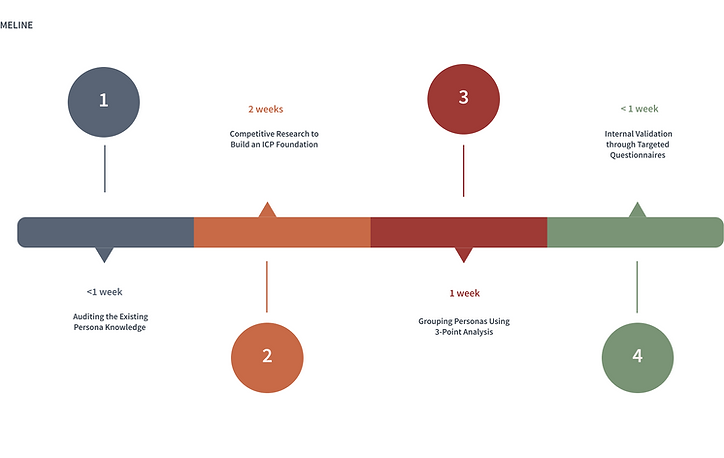Rameen Ghafoor
UX RESEARCHER
Case Study: B2B Personas – From chaos to clarity
Key Takeaways
By creating an evidence-based persona framework from scratch, using competitive research, internal insights, and structured clustering, I helped a startup align marketing and product with real decision-makers. This clarity enabled sharper campaign targeting and faster stakeholder buy-in for product positioning.




🧠 Project Context
When I joined the marketing team at a cloud platform startup, there was no structured persona system. The team loosely referred to two broad types: “User” “Buyer” But these were not real personas. They were: - Based on assumptions - Shared informally over Slack or Notion - Focused on company size and job titles, not motivations, behaviors, or pain points ➡️ Impact: Campaigns were disconnected from actual user needs. There was no way to target messaging, prioritize segments, or scale personalization.
🚀 My Role
Led a self-initiated revamp of B2B personas by auditing existing insights, conducting competitive research, building an ICP, and aligning persona-based messaging across the funnel — bringing strategic clarity to marketing and product teams.
🛠 Tools
- Design: Figjam - Research/Validation: user interviews, UAT pilots - Collaboration: Slack, Internal sheets
🧩 My Process & Product Ownership

1. Auditing the Existing Persona Knowledge
🧩Challenge:
I started by auditing everything the team had been using to represent “personas”: - Slack threads - Notion docs - Ad briefs and internal decks What I found? - Vague categorizations - No buying motivations or behavior insights - No mapping to the buyer journey ➡️ Conclusion: The knowledge was shallow, fragmented, and not actionable for marketing or product decisions.

The knowledge was shallow, fragmented, and not actionable for marketing or product decisions.
2. Competitive Research to Build an ICP(Ideal Customer Profile) Foundation
With no internal data to rely on, I pivoted to external intelligence: - Studied competitor client lists - Reviewed public case studies, testimonials, and industry blogs From this, I built an Ideal Customer Profile (ICP) that included: - Industry verticals - Team structures - Cloud maturity levels - Key pain points I then created 10+ initial persona candidates operating within that ICP, including: - Platform engineers, DevOps leads, CTOs, compliance officers, finance gatekeepers, etc.

Gartner reports that the average B2B buying group now includes 6 to 10 decision-makers, each with different roles, priorities, and pain points. - Primary personas (e.g., Platform Engineers, DevOps) are the users and champions. - Secondary personas (e.g., CTO, VP of Engineering) may approve or heavily influence, but aren’t hands-on. - Tertiary personas (e.g., Compliance, Procurement) can block a deal, but don’t seek or use the product. Why Use Persona Levels (Primary / Secondary / Tertiary)? - Because they have different buying triggers, goals, and outcomes - Because Not All Personas Deserve Equal Investment - Because Buyer Journeys Are Nonlinear By defining both the ICP and buyer personas, we can effectively target the right organizations and engage the key stakeholders within them, enhancing the efficiency and effectiveness of its go-to-market strategies. Source:https://www.gartner.com/en/digital-markets/insights/b2b-ideal-customer-profile

While ICP defines the right companies; personas define the humans inside them.
3. Grouping Personas Using 3-Point Analysis
To avoid duplicate personas, I created a clustering method based on 3 critical questions: Q1. What triggers their buying decision? Q2. What outcomes or features do they care about? Q3. How do they influence the purchase? ➡️ If personas shared at least 2 of 3 answers, they were grouped together. This resulted in three strategic groups: - Primary: Initiators and strategic influencers (e.g., Platform Engineers, CTOs) - Secondary: Indirect influencers (e.g., SREs, DBAs) - Tertiary: Gatekeepers (e.g., Finance, Compliance, Security)

4. Internal Validation through Targeted Questionnaires
To test and refine the clusters, I created a structured questionnaire for customer-facing teams: - Sales - Pre-sales engineers - Product marketing The survey avoided jargon and focused on uncovering: - Real concerns from prospects - Objections heard during sales - Language customers used to describe pain points ✅ Results: - Confirmed key hypotheses - Invalidated outdated beliefs - Uncovered new messaging opportunities


✅ Outcome & Impact
- Marketing team replaced ad-hoc targeting with 3 well-defined primary personas and supporting secondary/tertiary roles. - Campaign briefs now map directly to persona triggers → reduced review cycles and faster launch (≈20–30% faster content approval, based on team feedback). - Sales and product marketing reported clearer messaging resonance (less back-and-forth on “who we’re speaking to”). - Initiated an ongoing - UX/marketing sync that did not exist before, establishing a scalable process for future persona updates.
🪞 Reflection
This project taught me how to navigate complexity, build consensus, and create clarity — even in unstructured environments. Instead of waiting for perfect data, I used competitive research, internal insight, and structured thinking to bring user-centricity into a B2B space.
